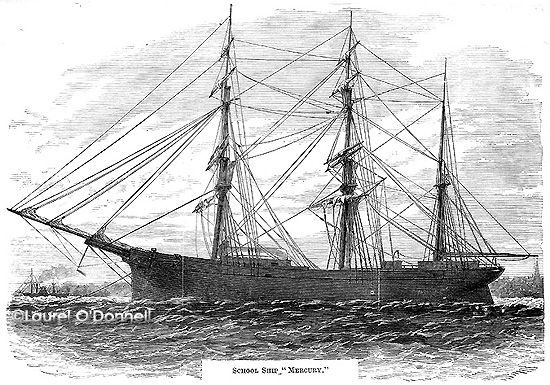|
|
Chapter IX
Institutions of Hart Island.
The School-Ship
Many boys in each generation are wild and adventurous in their natures, fond of excitements and dangers, and who will not sober down to the quietudes of ordinary industry. Neglected, they become the roughs, harbor thieves, pirates, and fillibusterers of the world. As early as 1812, Rev. Dr. Stanford, chaplain of the penal institutions of New York, recommended the separation of the youthful criminals from those more advanced, and urged the importance of training this adventurous class in a nautical ship for service on the sea. But reforms "hasten slowly," and though a citizen of Manhattan was the first to originate and recommend the plan of a training ship, the authorities of New York lingered until the experiment had been successfully tried in England and in Massachusetts. Under authority conferred by the Legislature, the Commissioners, in July, 1869, purchased the sail-ship Mercury, formerly belonging to the Havre line of packets, a fine vessel of 1,200 tons burden, which they have fitted for this service. The vessel is calculated to accommodate 250 or 300 boys, 'besides the usual complement of officers and drilled sailors. The boys, whose features for the most part show their foreign origin and treacherous tendencies, are all clothed in bright sailor's uniform, and governed on the apprenticeship system of the United States Navy. From the Industrial School they are transferred to the school-ship, where a year or two of good drilling is expected, to fit the more advanced for useful service in the Merchant Marine, or in the United States Navy. The vessel has already made several trips to sea, remaining outside the bar on one cruise four months At the 1st of January last, 826 boys had been received on board, and 565 discharged, many of whom had shipped as sailors in the United States Navy, and others had entered the Merchants' Marine.  School Ship "Mercury.". The daily routine adopted in port is as follows: At early daylight the reveille is beaten, all hands are called, and hammocks properly stowed by the Captains of Tops and other petty officers, to whom this duty belongs. This done, when the weather will permit, the decks are washed down, and if "Wash Clothes Day," hammocks and clothing are scrubbed, and triced up on the lines, while the boys are compelled to cleanse their persons, under the superintendence of the Offi- cer of the Deck. At 7.30 A.M., the boys are mustered, the line formed, and at 8 A.M., breakfast is piped and the boys marched to their respective messes on the berth-deck. This is in the charge of the Master at Arms and ship's Corporals, whose duty it is to preserve order there at all times. One hour is allowed the boys for the morning meal and recreation. At 9 A.M., the "hands are turned to," sweepers are piped, and the decks cleaned fore and aft. Ten minutes before "Colors," the drummer beats their call, hands stand by to lower boats, Quartermasters bend on their colors, Coxswains report boats ready for lowering, sail loosers are sent aloft, when necessary; lower booms got ready for going out, one hand stationed by the bell. At 9 A.M. in winter, at 8 A.M. in summer, the drummer rolls off, the bell is struck; at the third roll colors hoisted, boats lowered, sails let fall, and booms rigged out, to which the boats when lowered are hauled and made fast. |
|
263
:: Previous Page :: Next Page ::
:: Table of Contents :: :: New York State :: :: History Readings :: Books & articles appearing here are modified adaptations
from a private collection of vintage books & magazines. Reproduction of these pages is prohibited without written permission. © Laurel O’Donnell, 1996-2006.
|
|

